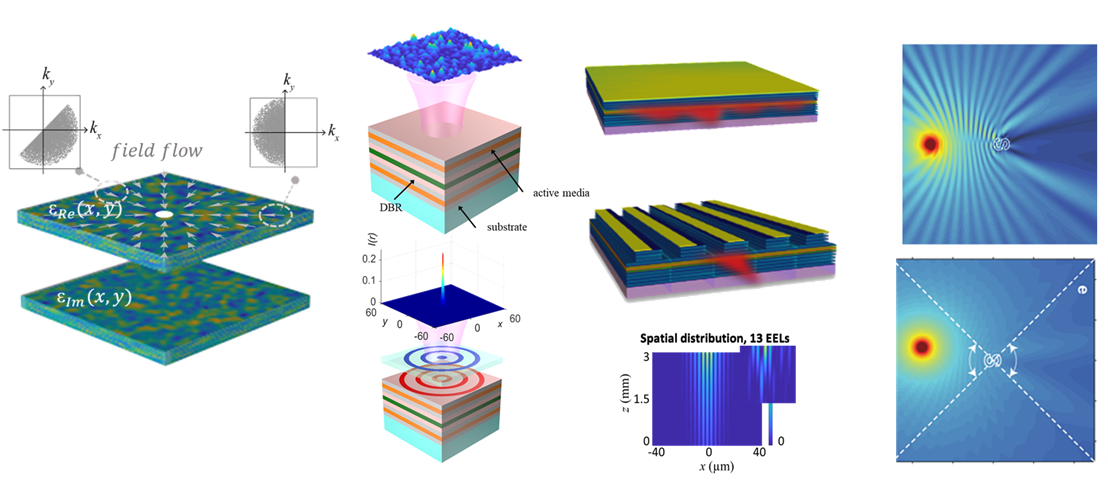Generalized Hilbert Transform. Non-Hermitian Photonics to control the flow of light
In the pursuit or artificial materials for a smat control of waves, non-Hermitian photonics has emerged as the ultimate path to design media that allow a unidirectional control of light flow, opening a new route to reshape light propagation. Structured media provide the momentum compensation for the scattering of waves. It is well-known that nano-scale modulations of the refractive index may lead to a temporal and spatial control over light propagation. Yet, also engineering the gain and loss profile uncovers analogous shaping effects. However, only the interplay between both the refractive index and gain and loss modulations introduces unidirectionality in light management.
Afetr intensive investigation on dielectric periodic structures for both their ability to engineer the temporal and spatial dispersion, at the DONLL group we investigated systems where gain and losses were modulated on the wavelength holding negative refraction or self-collimation effects.
However, as our main contribuyion to the field, we recently proposed Generalized Hilbert Transform connecting the real and imaginary parts of the permittivity distributions of to induce spatial symmetry breaking to control scattering, widening the concept Kramers Kronig relations in space. A recipe to design complex potentials to tailor the propagation of light following any vector field, or to generate invisible objects of demand (for given directions and frequency ranges). The procedure may be applied on any given arbitrary background permittivity distribution being regular or random, extended or localized. Moreover, it is possible to keep the design parameters within practical limits for a feasible realization, even avoiding gain or reducting the dimensionality of the complex susceptibility . Beyond this fundamental approach, we also investigate supervised and unsupervised learning techniques for knowledge acquisition in non-Hermitian systems to accelerate the inverse the “on demand” design process.
These proposals may have direct applications to control the wave dynamics in semiconductor lasers or other linear and nonlinear physical systems including cloaking sensors and arbitrary shaped objects ot regularizing the emission from VCSELS and edge-emitting lasers or laser arrays.

Involved Researchers from UPC: M. Botey, K. Staliunas, R. Herrero
Former PhD Students: W. W. Ahmed, J. Medina
Associated projects
Control inteligente de ondas de Luz con Metamateriales, metasuperficies y medios no-Hermíticos
Scientific coordinator: R. Herrero, K. Staliunas
Funding Agency: Ministerio de Economía y Competitividad.
Participants: R. Herrero, K. Staliunas, M. Botey, Y. Cheng, D. Gailevicius, V. Kuzmiak, W. Ahmed, A. Perego, H. Kurt, S. B. Ivars, S. Gawali, J. Medina, G. Garre
Project ref. No.: PID2019-109175GB-C21
Partners: Aston University, TOBB University of Economics and Technology, Vilnius University, Taipei Tech, King Abdullah University of Science and Technology, Institute of Information Theory and Aut. Science Acad. of Czech Rep
Dinàmica no Lineal, Òptica no Lineal i Làsers
Scientific coordinator: C. Masoller
Funding Agency: Agència De Gestió D'ajuts Universitaris I De Recerca (agaur)
Participants: K. Staliunas, J. Trull, C. Cojocaru, M. Botey, R. Herrero, A. Pons, C. Serrat, R. Vilaseca
Project ref. No.: 2021 SGR 00606
Share: